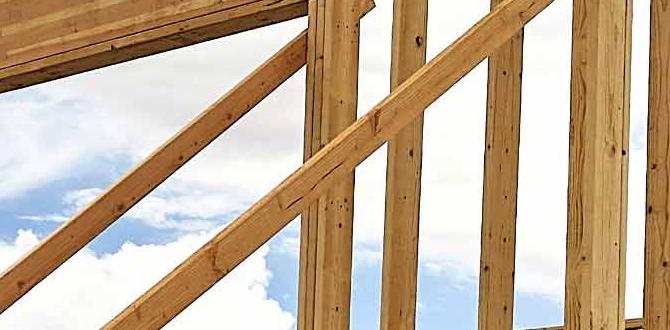Quick Summary
Understanding nailer spring strength is key for choosing the right tool. Different springs power nail guns for various tasks; weaker springs are for delicate jobs, while stronger ones handle framing. This guide breaks down what you need to know.
Hey there, DIYers and woodworkers! Jack Shaffer here from Nailerguy. Ever grabbed a nailer and felt like it just wasn’t sinking nails deep enough, or maybe it was overpowering your delicate trim work? That subtle but crucial difference often comes down to the nailer’s spring strength. It’s a detail that can make or break your project. Don’t worry, we’ll sort it out together! You’ll learn what spring strength is, why it matters, and how to pick the perfect nailer for your next big (or small!) idea. Let’s get your projects looking professional and feeling effortless!
Table of Contents
What is Nailer Spring Strength?
At its heart, a nailer is a tool that uses a spring-loaded mechanism to drive nails. Think of it like a tiny, powerful hammer that’s much faster and more precise. Spring strength refers to how much force that internal spring can exert when it’s released. A stronger spring means more force, which translates to the nailer being able to drive larger, thicker nails deeper into harder materials.
Conversely, a weaker spring delivers less force. This is perfect for lighter-duty tasks where you don’t want to damage softer woods or thin materials. Understanding this difference is the first step to making sure your nailer is up to the job without causing damage.
Why Nailer Spring Strength Matters for Your Projects
Choosing the right nailer with the appropriate spring strength can significantly impact the success and quality of your DIY projects. It’s not just about power; it’s about precision and material compatibility. Let’s break down why this detail is so vital:
- Project Success: Using a nailer with inadequate spring strength might lead to nails not sinking fully, requiring manual hammering – which defeats the purpose of a nailer! On the other hand, too much power can split wood or leave unsightly divots.
- Material Preservation: Different woods and materials have varying densities. A nailer with adjustable depth or appropriate spring strength allows you to work with everything from soft pine to hardwoods without damaging the surface.
- Efficiency and Speed: The right spring strength ensures nails are driven quickly and effectively, saving you time and effort. This is especially important for repetitive tasks like installing trim or building frames.
- Tool Longevity: Using a nailer for tasks it wasn’t designed for (e.g., using a trim nailer for framing) can overwork the spring and motor, potentially damaging the tool and shortening its lifespan.
Think of it like using the right screwdriver bit for a screw. Using the wrong one can strip the screw head. Similarly, using a nailer with the wrong spring strength can cause problems for your project and your tool.
Decoding Nailer Types and Their Spring Strength
Nail guns come in many varieties, each designed for specific applications. The type of nailer often gives a good indication of its typical spring strength. Let’s look at some common types and what they’re usually good for:
Framing Nailers
These are the heavyweights. Framing nailers are built for structural work – think building house frames, decks, or fences. They need to drive large nails (often 2 to 3.5 inches long) through thick lumber. To do this, they boast the strongest springs and most powerful motors, whether pneumatic or cordless. Their high spring strength ensures nails are fully seated, even in dense hardwoods.
Construction or Common Nailers
These are versatile workhorses, often used for various construction tasks that aren’t quite as demanding as framing. They can handle a range of nail sizes and are suitable for subflooring, sheathing, and building larger wooden structures. Their spring strength is robust, but typically a notch below dedicated framing nailers, offering a good balance of power and control for general building.
Finish Nailers
Finish nailers are designed for attaching trim, molding, and other decorative wood pieces. They use smaller, thinner nails that are less likely to split the wood. Consequently, they have moderate spring strength. This allows for precise placement without damaging delicate surfaces. You’ll often find adjustable depth settings on finish nailers to fine-tune how deep the nail sinks.
Brad Nailers
Brad nailers are for very fine work, like attaching small trim pieces, delicate moldings, or assembling small craft projects. They use very thin brad nails, typically only visible as tiny pinholes when the job is done. Brad nailers have the weakest spring strength among the common nailer types. This gentle power is essential for preventing any noticeable damage to soft woods or thin veneers.
Pin Nailers
These are the most delicate of the bunch. Pin nailers drive tiny, headless pins. They are used for the most intricate tasks, like attaching small decorative elements, holding pieces in place while glue dries, or working with very thin materials. Their spring strength is minimal, designed purely for holding parts together without any significant impact on the material’s surface. They are great for furniture making and detailed craft projects.
It’s important to note that even within these categories, there can be variations. Cordless nailers, for instance, might have slightly different power delivery characteristics compared to pneumatic ones, though the principle of spring strength remains the same.
Understanding Nail Size and Material Compatibility
Nailer spring strength is directly related to the size and type of nail it can effectively drive, and this, in turn, dictates the materials it’s best suited for. Let’s delve into how these elements work together.
Nail Sizes and Types
Nails come in various lengths, gauges (thickness), and head styles, each suited to different applications. Spring strength determines which of these a nailer can competently drive.
- Framing Nails: These are thick, long nails (2-3.5″ length, 10-13 gauge). They require a strong spring to penetrate structural lumber.
- Common Nails: Slightly smaller than framing nails (1.5-2.5″ length, 8-14 gauge). Used for general construction, requiring moderate-to-high spring strength.
- Finish Nails: Thinner and shorter (1.25-2.5″ length, 16-18 gauge) with small heads. Used for trim and molding. Moderate spring strength is sufficient.
- Brad Nails: Very thin (0.5-1.25″ length, 18-20 gauge) with tiny heads. For delicate trim and craftwork. Low spring strength is ideal.
- Pin Nails: The thinnest and shortest nails (0.5-1″ length, 23-24 gauge) with no heads. For the most delicate tasks. Minimal spring strength needed.
The gauge of a nail is its diameter. A lower gauge number means a thicker nail. Driving thicker nails requires more force.
Material Hardness
The material you are fastening into is just as important as the nail you are using. A nailer’s spring strength needs to be sufficient to drive the nail through the target material.
- Softwoods (Pine, Fir, Cedar): These are easy to drive nails into. Even a lighter nailer can sink nails effectively.
- Medium-Density Woods (Oak, Maple): These woods require more force. You’ll need a nailer with adequate spring strength, especially for longer or thicker nails.
- Hardwoods (Hickory, Ipe): These are the most challenging. They often require powerful nailers with strong springs to drive nails without bending them or without them failing to seat properly.
- Engineered Wood Products (Plywood, MDF): These materials vary. Plywood can be dense, while MDF can be powdery and may not hold fasteners as well as solid wood, especially if over-driven.
How Spring Strength and Nail/Material Interact
Imagine trying to push a toothpick into a brick versus a piece of styrofoam. It’s the same idea with nailers.
- Too Weak: If a nailer’s spring is too weak for the nail size and material, the nail won’t go in all the way. You’ll have nails sticking out, which looks unprofessional and can be a safety hazard.
- Just Right: The spring is strong enough to drive the nail to the desired depth without excessive force. This is efficient and provides a clean finish. For finish and brad nailers, “just right” means the nail head is slightly countersunk or flush, not breaking the surface.
- Too Strong: If the spring is too powerful for a delicate material or a small nail, it can drive the nail too deep, shatter the wood fibers around it, or cause the head of the nail to sink too far, creating a large divot that requires filling. This is why adjustable depth is so useful.
When selecting a nailer, always consider the typical nails you’ll be using and the types of wood you’ll be working with. For projects involving a mix of materials or nail sizes, look for nailers with adjustable depth features.
Pneumatic vs. Cordless Nailer Spring Strength
The power source of a nailer plays a role in how spring strength is delivered and perceived, though the underlying principle of spring force remains consistent. Let’s compare pneumatic and cordless nailers in terms of their spring strength and power delivery.
Pneumatic Nailers
Pneumatic nailers use compressed air from an air compressor to drive nails. The air
pressure (measured in PSI, pounds per square inch) directly dictates the force applied.
This force acts on a piston connected to the nailer’s driver blade, which then strikes the
nail. The ‘spring’ aspect often refers to the return mechanism that resets the piston and
driver blade after firing.
- Pros: Generally offer the highest power and consistent driving force. Adjusting air pressure allows for precise control over the force applied, effectively fine-tuning the “spring strength” output for different tasks. They tend to be lighter in hand due to the external compressor.
- Cons: Require an air compressor, hose, and an air source, making them less portable. Setting up can be more involved.
For pneumatic nailers, your “spring strength” control often comes from adjusting your compressor’s regulator. A higher PSI setting will drive nails deeper and more powerfully. You can find recommended PSI ranges for most nailers at manufacturer websites like DeWalt or in your tool’s manual. It’s crucial to operate within the tool’s specified PSI range to avoid damage or poor performance.
Cordless Nailers (Battery-Powered)
Cordless nailers use batteries to power a motor. This motor then drives a mechanism that propels the nail. There are a few common technologies:
- Gas/Fuel Cell: These nailers use a small burst of flammable gas ignited by a spark plug, which drives a piston. A spring then resets the mechanism.
- Electric Motor/Fan (Impulse): Some nailers use a battery to spin a flywheel or fan at very high speeds. The sudden stopping of this mechanism drives the nail. This is less about a traditional “spring” and more about kinetic energy.
- Direct Drive (Hammer Mechanism): These use the battery to power a motor that directly drives a spring-loaded plunger or creates a percussive impact.
The “spring strength” in cordless nailers is often pre-determined by the motor and internal mechanism design for that specific tool model. Some higher-end models offer adjustable depth control, and a few might have selectable power modes, which mimic adjustments in force.
- Pros: Highly portable, no cords or hoses needed. Quick and easy to set up and use anywhere.
- Cons: Can be heavier due to the battery. Driving power can sometimes be less consistent than pneumatic, especially under heavy load or with lower battery charge. Battery life is a consideration.
Comparison Table: Pneumatic vs. Cordless Power Delivery
Here’s a quick comparison to help visualize the differences:
| Feature | Pneumatic Nailers | Cordless Nailers (Battery) |
|---|---|---|
| Power Source | Air Compressor | Rechargeable Battery |
| “Spring Strength” Control | Primarily by adjusting air pressure (PSI) on the compressor regulator. | Often inherent to the tool’s design; some models have depth adjustment or power settings. |
| Consistency of Power | Very consistent when air pressure is maintained. | Can be consistent, but may vary slightly with battery charge or load. |
| Portability | Limited by hose and compressor. | High portability; freedom of movement. |
| Typical Use Case | Workshops, job sites where compressor is available; higher-demand applications. | On-site, remote locations, smaller repairs, trim work, everyday DIY. |
| Cost (Initial) | Lower for the nailer itself, but requires compressor (higher overall investment). | Higher initial cost for the tool and battery system. |
Ultimately, both types of nailers can achieve excellent results. For the absolute strongest driving power and finest control over force, pneumatic often has the edge. However, modern cordless nailers are incredibly capable and offer unmatched convenience and portability for a wide range of DIY and professional tasks.
How to Test and Adjust Nailer Spring Strength (Depth of Drive)
While you can’t usually swap out springs in modern nailers like you might in a toy car, you can control how deeply the nail is driven, which effectively manages the impact of the spring’s force. This is most commonly done through adjustments on the nailer itself, or indirectly with pneumatic tools.
For Cordless/Electric Nailers: Depth Adjustment Dial
Most modern finish, brad, and even some framing nailers (especially cordless models) come with a depth adjustment feature. This is usually a dial or a lever located near the nose of the nailer.
How to Use It:
- Start with a Test Piece: Always grab a scrap piece of the same material you’ll be working with.
- Set to a Medium Depth: If your dial has numbers or markings, start somewhere in the middle. If it’s just marked with +/- or a visual indicator of depth, aim for a mid-point.
- Drive a Nail: Position the nailer flush against the material and pull the trigger.
- Inspect the Nail: Check how deep the nail is.
- Too Deep (Head is sunk too far in, damaging wood): Turn the dial to reduce depth (usually by moving towards a “-” symbol or a higher number on some dials).
- Not Deep Enough (Head is proud, sticking out): Turn the dial to increase depth (usually by moving towards a “+” symbol or a lower number on some dials).
- Just Right (Head is flush or slightly countersunk): Perfect!
- Repeat Testing: Drive a few more nails with your adjustment, checking each one until you achieve the desired result.
This depth adjustment effectively controls how far the nose of the nailer engages with the surface before firing, or it can regulate the travel of the driver blade. It allows you to fine-tune the impact of the spring’s force without altering the spring itself.
For Pneumatic Nailers: Air Pressure (PSI)
As discussed, pneumatic nailers rely on regulated air pressure. The “spring strength” is directly influenced by the PSI you set on your air compressor’s regulator.
How to Use It:
- Check Tool Specs: Find the recommended operating PSI range for your specific nailer. This is usually printed on the tool, in the manual, or on the manufacturer’s website. Operating outside this range can damage the tool or lead to poor performance. For example, a framing nailer might operate at 70-120 PSI, while a brad nailer might only need 40-70 PSI.
- Connect Compressor and Nailer: Hook everything up securely.
- Set Your Regulator: With the nailer not firing, slowly adjust the regulator on your air compressor to the lower end of the recommended PSI range for your tool.
- Test on Scrap Material: Hold the nailer against a scrap piece of your work material and fire a nail.
- Inspect the Nail:
- Too Deep: If nails are sinking too far, reduce the air pressure slightly.
- Not Deep Enough: If nails are not fully seating, increase the air pressure slightly.
- Fine-Tune: Make small



